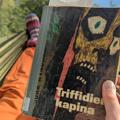This was technically a reread for me, but the last time I read it, the century had not yet turned—and in any case, I remembered nothing about it, other than something about a cave or tunnels.
The Tombs of Atuan is quite good, but I see why it is, perhaps, less popular than some of Le Guin’s other works. It’s a sequel to A Wizard of Earthsea, but where Earthsea is practically a fairy tale in tone, stylized and sonorous (which is an endorsement, not a criticism, by the way), Atuan is more directly a “fantasy novel.” It is not, however, a comforting one, not one where all the pieces fall together nicely, everybody’s problem is solved, the main characters fall in love, and so forth.
It is a story of beginnings, I think: first of the protagonist’s life as Arha, and then, the re-beginning—or perhaps better said, the resumption of the beginning—of it as Tenar. The quest which is completed, for the Ring of Erreth-Akbe, is Ged’s quest, not Tenar’s; and as such is mentioned only in passing, only enough as needed to satisfy plotting, since this is her story, not Ged’s. She escapes: with his help, she sees through the lies and shackles laid upon her as Arha, and so she sails with Ged to his own lands, where he has promised he will make a place for her, first, temporarily, with the “princes and rich lords” and eventually, more permanently, with his own master and teacher, the wise mage Ogion, none of whom she has ever known. The book ends as they have sailed into the harbor with the Ring, whose magic promises peace and order:
Tenar sat in the stern, erect, in her ragged cloak of black. She looked at the ring about her wrist, then at the crowded, many-colored shore and the palaces and the high towers. She lifted up her right hand, and sunlight flashed on the silver of the ring. A cheer went up, faint and joyous on the wind, over the restless water. Ged brought the boat in. A hundred hands reached to catch the rope he flung up to the mooring. He leapt up onto the pier and turned, holding out his hand to her. ‘Come!’ he said smiling, and she rose, and came. Gravely she walked beside him up the white streets of Havnor, holding his hand, like a child coming home.
She may be like a child coming home, in the sense that, having begun her new reassumed life, she must trust him, and he leads her, but the irony is that however much like that child she may be, she cannot go home, for at this point in the story she has no home. Nor do any of those purportedly “joyous” actually know her; they only see what the ring she wears represents. All that she had is gone, and even Ogion’s wisdom is only a promise for the future. For her, however gravely (and bravely) she faces it, there is no indication here of what happens next—her quest has just begun.
Compare it to the ending of A Wizard of Earthsea, where Ged, having sought and defeated the “shadow” with the help of his friend Estarriol, returns to the latter’s home island, where his sister waits for them.
[T]he voyage to Iffish was not long. They came in to Ismay harbor on a still, dark evening before snow. They tied up the boat Lookfar that had borne them to the coasts of death’s kingdom and back, and went up through the narrow streets to the wizard’s house. Their hearts were very light as they entered into the firelight and warmth under that roof; and Yarrow ran to meet them, crying with joy.
This is the end of the arc, not the beginning. It’s a quieter but more real homecoming, to hearth and family and the promise of belonging. The contrast to the end of Tenar’s story could not be more striking. She has only possibility, and hope.
Besides what I’ve noted above, there is another aspect to the book’s realism, too, which Le Guin herself notes in the afterward in the edition I have.
Some people have read the story as supporting the idea that a woman needs a man in order to do anything at all (some nodded approvingly, others growled and hissed). Certainly Arha/Tenar would better satisfy feminist idealists if she did everything all by herself. But the truth as I saw it, and as I established it in the novel, was that she couldn't. My imagination wouldn't provide a scenario where she could, because my heart told me incontrovertibly that neither gender could go far without the other. So, in my story, neither the woman nor the man can get free without the other…. Each has to ask for the other's help and learn to trust and depend on the other. A large lesson, a new knowledge for both these strong, willful, lonely souls.
Not really in line with the sort of individualistic ethos which held sway when Le Guin was writing, and still holds most of society in its grip today.
All of which is a long-winded way of saying, my point is that The Tombs of Atuan disappoints, potentially, both those who loved A Wizard of Earthsea and wanted more, not something different, as well as those—though surely the groups aren’t mutually exclusive—who want escapism, not realism, out of their fantasy. (Not that Earthsea is escapist in that sense either.) But even if those describe you, I still think you should read Atuan. Just know what you’re getting into.






